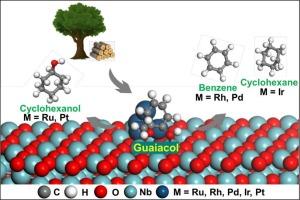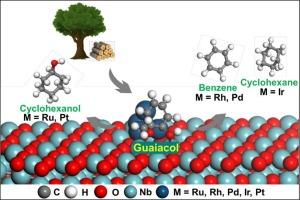愈创木酚加氢脱氧过程中M4/Nb2O5催化剂对产物定向选择性的调控
IF 6.5
1区 化学
Q2 CHEMISTRY, PHYSICAL
引用次数: 0
摘要
愈创木酚加氢脱氧(HDO)是木质素增值过程中的一个关键反应,可以产生高辛烷值、低氧化合物,如苯和环己烷。然而,由于复杂的反应网络,对产物选择性的精确控制仍然是一个主要的挑战。本文采用密度泛函理论(DFT)研究了愈木酚HDO在5种Nb2O5 (M4/Nb2O5, M = Ru, Rh, Pd, Ir, Pt)金属团簇上的反应机理和产物选择性。结果表明,Ru4和Pt4簇优先稳定芳香环的吸附,从而促进环加氢生成环己醇。相反,Rh4/Nb2O5和Pd4/Nb2O5促进C-O键选择性裂解,限制环加氢,有利于苯的形成。值得注意的是,Ir4/Nb2O5使环氢化完全,C-OH键断裂,形成环己烷为主要产物。实验结果证实,Pd/Nb2O5和Ir/Nb2O5催化愈创木酚转化为完全脱氧产物(苯和环己烷),转化率为70 %。相关研究证实,金属团簇的电负性通过金属与载体之间的协同作用,强烈影响反应的活性和选择性。这些发现阐明了HDO性能背后的结构-活性-选择性关系,并为合理设计针对木质素衍生化合物的选择性脱氧催化剂提供了有价值的见解。本文章由计算机程序翻译,如有差异,请以英文原文为准。


Regulation of M4/Nb2O5 catalysts toward directed product selectivity in guaiacol hydrodeoxygenation
Guaiacol hydrodeoxygenation (HDO), a key reaction in lignin valorization, enables the production of high-octane, low-oxygen compounds such as benzene and cyclohexane. However, precise control over product selectivity remains a main challenge due to the complex reaction network. In this work, density functional theory (DFT) calculations were employed to investigate the mechanism and product selectivity of guaiacol HDO over five metal clusters supported on Nb2O5 (M4/Nb2O5, M = Ru, Rh, Pd, Ir, Pt). The results show that Ru4 and Pt4 clusters preferentially stabilize the adsorption of aromatic rings, thereby facilitating ring hydrogenation to form cyclohexanol. In contrast, Rh4/Nb2O5 and Pd4/Nb2O5 promote selective C–O bond cleavage with limited ring hydrogenation, favoring the formation of benzene. Notably, Ir4/Nb2O5 enables complete ring hydrogenation and C–OH bond cleavage, resulting in the formation of cyclohexane as the main product. Experimental results confirmed that Pd/Nb2O5 and Ir/Nb2O5 catalyze the conversion of guaiacol to fully deoxygenated products (benzene and cyclohexane), with a conversion rate of 70 %. The correlation study has confirmed that the electronegativity of metal clusters strongly affects the activity and selectivity of the reaction through the synergistic effect between the metal and the support. These findings elucidate the structure–activity–selectivity relationships underlying HDO performance and offer valuable insights for the rational design of selective deoxygenation catalysts targeting lignin-derived compounds.
求助全文
通过发布文献求助,成功后即可免费获取论文全文。
去求助
来源期刊

Journal of Catalysis
工程技术-工程:化工
CiteScore
12.30
自引率
5.50%
发文量
447
审稿时长
31 days
期刊介绍:
The Journal of Catalysis publishes scholarly articles on both heterogeneous and homogeneous catalysis, covering a wide range of chemical transformations. These include various types of catalysis, such as those mediated by photons, plasmons, and electrons. The focus of the studies is to understand the relationship between catalytic function and the underlying chemical properties of surfaces and metal complexes.
The articles in the journal offer innovative concepts and explore the synthesis and kinetics of inorganic solids and homogeneous complexes. Furthermore, they discuss spectroscopic techniques for characterizing catalysts, investigate the interaction of probes and reacting species with catalysts, and employ theoretical methods.
The research presented in the journal should have direct relevance to the field of catalytic processes, addressing either fundamental aspects or applications of catalysis.
 求助内容:
求助内容: 应助结果提醒方式:
应助结果提醒方式:


